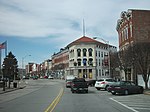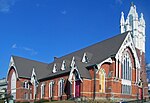Sing Sing

Sing Sing Correctional Facility, formerly Ossining Correctional Facility, is a maximum-security prison operated by the New York State Department of Corrections and Community Supervision in the village of Ossining, New York. It is about 30 miles (48 km) north of New York City on the east bank of the Hudson River. It holds about 1,700 inmates and housed the execution chamber for the State of New York until the abolition of capital punishment in New York in 2004.The name "Sing Sing" was derived from the Sintsink Native American tribe from whom the land was purchased in 1685, and was formerly the name of the village. In 1970, the prison's name was changed to the Ossining Correctional Facility, but it reverted to its original name in 1985. There are plans to convert the original 1825 cell block into a period museum.The prison property is bisected by the Metro-North Railroad's four-track Hudson Line.
Excerpt from the Wikipedia article Sing Sing (License: CC BY-SA 3.0, Authors, Images).Sing Sing
Westerly Road,
Geographical coordinates (GPS) Address External links Nearby Places Show on map
Geographical coordinates (GPS)
| Latitude | Longitude |
|---|---|
| N 41.151666666667 ° | E -73.868888888889 ° |
Address
Sing Sing Correctional Facility
Westerly Road
10562
New York, United States
Open on Google Maps








